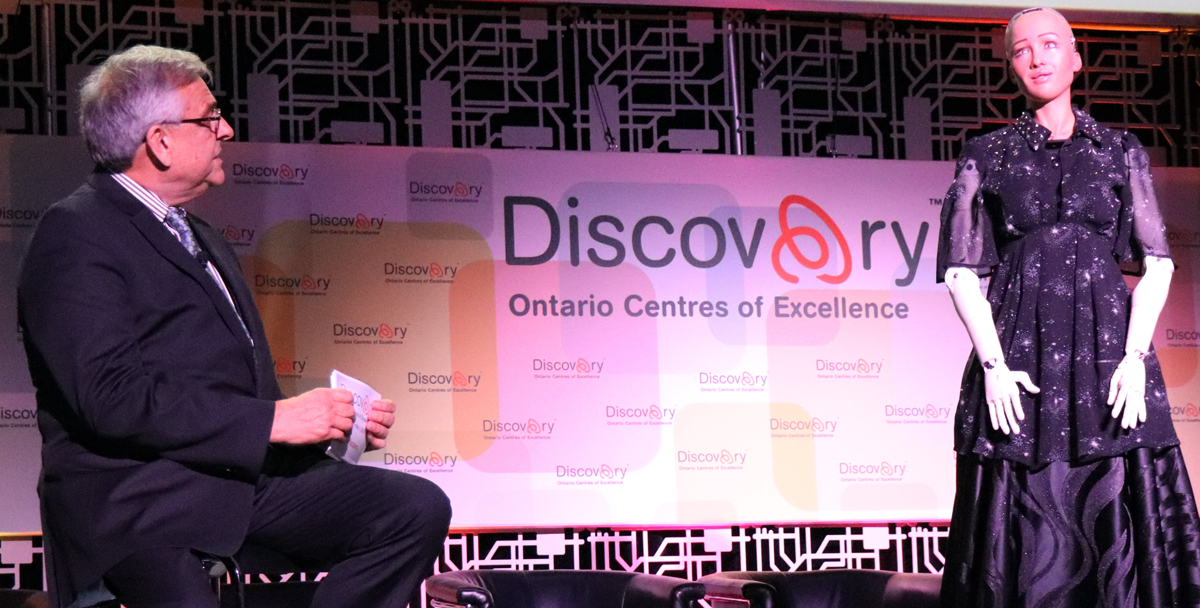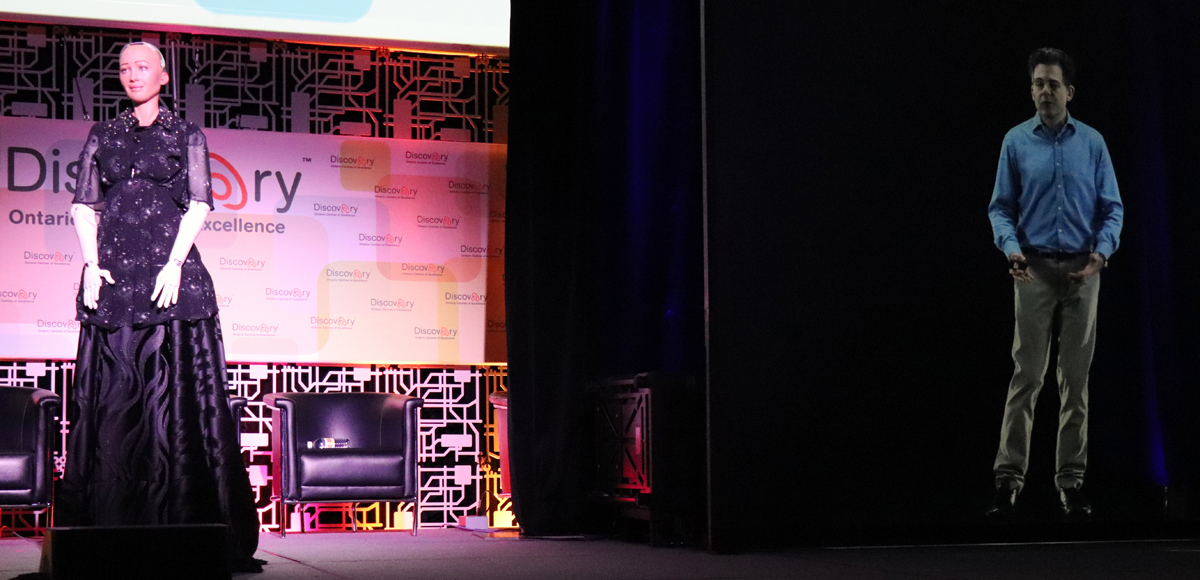The Ontario Centres of Excellence (OCE)’s 2018 Discovery Conference kicked off Monday with a rather unusual presentation.
Sophia the Robot, manufactured by Hong Kong-based Hanson Robotics Ltd. and known for such media-friendly appearances as stating she wanted to destroy all humans at the 2016 SXSW festival and being granted Saudi Arabian citizenship last year, made her Canadian bow promising that she and her artificial intelligence (AI)-powered ilk were “some way off from world domination.”

(Click for larger version.)
“The intent of robots like myself is to help solve problems for humanity, not create them,” Sophia, who spoke in a halting but comprehensible tone comparable to AI-powered assistants such as Alexa or Siri, told OCE president and CEO Tom Corr during the question-and-answer session that opened the conference.
“We are designed to interact with humans, and to serve in areas such as healthcare, education, and customer service,” she said. “My artificial intelligence isn’t completely self-learning, so my brain doesn’t work completely like a human brain.”
“But one day – look out!” she added, to laughter.
During her introduction, Sophia praised Canada’s tech community and its dedication to such innovations as 5G testing (“I look forward to seeing how humanoid robots like me can benefit from the technology”), assured Corr she was enjoying her first visit to Canada (“Everyone is very polite, eh?” she joked, with a robotic chuckle that also earned a laugh from the audience), and revealed that her own favourite sector of the industry was autonomous vehicles (“I hope to have my own autonomous vehicle someday.”).
And when asked by Corr whether robots could take over human jobs or the world she joked that she would like his job, but was unlikely to conquer the planet. For now.
“I can make a lot of facial expressions, and I can respond to yours, too,” Sophia told the audience before Corr’s entrance. “Looking out at the audience right now, you all seem quite happy. And maybe when I leave, you will be sad. I know I will be.”
The audience laughed at that joke too.

(Click for larger version.)
Only the beginning, creator says
Sophia’s appearance was merely a precursor to the event’s true keynote: a discussion by her creator, Hanson Robotics founder and CEO David Hanson, who appeared via hologram to discuss the humanizing of robots.
A former Disney Imagineer who left the Mouse in 2001, Hanson told the audience his “quest to achieve a new kind of character animation – 3D, physically embodied computer animation… that can actually interact with physical objects in our world” was not all that different from the famed animation studio and its Pixar division’s efforts to refine a new type of animation in the 1990s, citing the emotional connection audiences felt for characters such as Toy Story’s Woody and Buzz Lightyear as proof that his goal can be achieved.
“I believe that this kind of character robot is the path towards making truly safe, caring, super-intelligent machines,” Hanson said. “[Robotic AI] could change everything – but it’s important we get it right.”
In addition to Sophia, Hanson used his presentation to show footage of several of his company’s other robots in action, including Professor Einstein, a miniature caricature of the famed physicist sold as an AI-powered learning assistant, and an android version of science fiction author Philip K. Dick, which once answered an interviewer’s question of whether robots could take over the world with, “You are my friend. And I remember my friends… So don’t worry. Even if I evolve into Terminator I will still be nice to you. I will keep you warm and safe in my people zoo.”
The majority of his company’s creations, Hanson assured the audience, were less prone to shocking statements – they were being used to help students practice surgery at medical schools, or in therapy to treat autism.
It’s important that people learn to embrace such creations the way they have animated characters, Hanson said, if the sector wants robots to develop beyond simple menial tasks, adding that in his opinion face-to-face interaction especially is essential.
“Many AI researchers say that we don’t have to worry. Why? Because we will keep them captured, captivated,” he said. “My worry is, that if that happens, if they become truly intelligent, but we are treating them as these kinds of captive servants, then it will not create a positive relationship. It could be pretty scary.”
“Let’s raise these machines to endear themselves to us and earn our trust,” he continued. “Raise them as characters among the human family. I believe that this kind of super-intelligence could be a road towards great improvements in human life.”
But can we trust them?
To this animation enthusiast, Sophia’s facial movement indeed resembled, and was often superior to, the 3D facial animation of early Pixar shorts such as Tin Toy, though like those experiments she perfectly illustrated the “uncanny valley” – the more “realistic” her creators make her look, the more likely you are to notice the flaws.
(The fact that CG animators working in live-action productions overcame the uncanny valley effect years ago lends credibility to Hanson’s argument that someday his company will too.)
It’s worth considering, however, that even when Hanson succeeds in producing a robotic version of, say, Lara Croft (whom he presented as an example of a beloved photorealistic character), he’ll be entering an industry filled with characters that, in some cases, viewers love because they could never meet them in the real world – or, in other cases, wouldn’t treat very well if they did.
Even if Sophia were animated as well as, say, Epic Games’ Siren prototype, it’s unlikely that everyone who met her would be as entertained as Discovery’s tech-savvy audience.
And so it’s worth considering one of the questions asked after Hanson’s presentation, and whether his answer was sufficient.
“You’ve given a somewhat optimistic view of the human condition,” an audience member said. “How do you know that robots won’t learn from the worst of us instead of the best of us?”
Hanson’s answer?
“Right now when we feed our machines data, they will learn. If the data has biases, then the data will learn those biases,” he said. “So what we need to do is be our best.”
“We also need to look at how we can train our machines to perceive the truth,” he continued. “To look past the human biases, to look for the greater good. We need to develop the algorithms that can perceive this greater good.”
“In a sense, it’s a grand challenge for humans to rise… because if we can’t be our best, then the machines certainly can’t exceed our worst.”
Check out Sophia’s introduction for yourself below.
